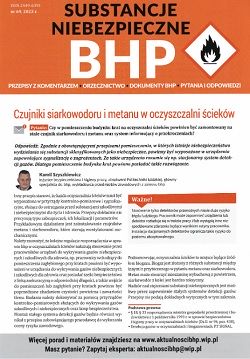
- Hydrogen sulphide and methane sensors in a sewage treatment plant
- Should a hydrogen sulphide and methane sensor and a system informing about exceedances be permanently installed in the grate building room at the sewage treatment plant? (1)
In accordance with the applicable regulations, rooms where there is a risk of secretion of substances classified as dangerous should be equipped with devices providing signaling of hazards. Such devices include, for example, a stationary gas detection system. Therefore, the grate building room should have such a solution.
- New template of the safety data sheet from January 1, 2023.
- From January 1, 2021, Commission Regulation (EU) 2020/878 of June 18, 2020 amending Annex II to the REACH Regulation applies. According to it, from 1 January 2023, only one safety data sheet template is valid. Therefore, should the existing safety data sheets of substances used in the workplace be changed and a safety data sheet obtained from the manufacturer according to the new requirements? But can they remain as they are? How to deal with purchased chemicals and their safety data sheets from January 2023? (2)
From January 2023, safety data sheets should be developed in accordance with the new template.
- A minor worker in a warehouse of hazardous substances
- Can an employee who is a student (performs apprenticeship in a company under a contract with a vocational school) and is 16 years old, be allowed to perform cleaning work in a warehouse of hazardous substances? What special considerations should be taken into account when planning this work, what things should be avoided, what special attention should be paid to? What can an underage employee not do according to the regulations? (3)
A juvenile employee who is a student (performs work as part of an apprenticeship) cannot perform cleaning work in a warehouse of hazardous substances. These works should be classified as works involving exposure to the harmful effects of chemical agents, even when these substances are stored in containers.
- Biological factors during the exhumation of corpses
- What biological factors are present during the exhumation of a corpse? Please include for each type, i.e. for each name of the factor - risk group, transmission route and effects on humans and prevention (4)
Each exhumation of corpses/remains, performed especially before the end of the mineralization period, carries the risk of infection with microorganisms developing in the corpse. Due to the protection of human health and life, it can only be performed while maintaining the appropriate sanitary regime.
Aktualności BHP (OSH News) - the whole list







